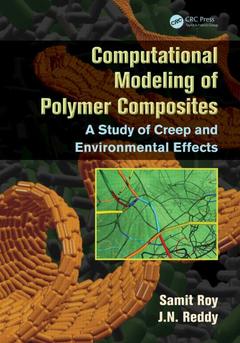Computational Modeling of Polymer Composites A Study of Creep and Environmental Effects Applied and Computational Mechanics Series
Auteurs : Roy Samit, Reddy J.N.

Computational Modeling of Polymer Composites: A Study of Creep and Environmental Effects details the development of polymeric materials and their use in smart materials and composite structures in aerospace and automotive industries. Based on the authors' work during the past 30 years, this book provides a strong understanding of the theories and associated finite element life-prediction models for elastic and viscoelastic response of polymers and polymer composites in aggressive environments. The subject is an interdisciplinary one where chemists, material scientists, and chemical, mechanical, and structural engineers contribute to the overall product.
Books on polymer composites are usually of three types: material science, mechanics, and computational. This book combines mechanics of materials with the computational element. The authors suggest an introductory course on mechanics of materials to cover all bases. The book begins with mathematical preliminaries, equations of anisotropic elasticity, virtual work principles, and variational methods. It provides an introduction to the finite element method and finite element analysis of viscoelastic materials, and then moves on to the solvent diffusion process in polymers and polymeric composites, as well as the linear and nonlinear viscoelastic models and the implementation of finite element models of viscoelastic materials.
Computational Modeling of Polymer Composites: A Study of Creep and Environmental Effects delves into both uniaxial and multiaxial cases and delayed failure before discussing the finite element analysis of the nonlinear diffusion process in polymers. It also includes non-Fickean diffusion of polymers, the coupled hygrothermal cohesive layer model for simulating debond growth in bimaterial interfaces, and the viscoelastic cohesive layer model for the prediction of interlaminar shear strength of carbon/epoxy composites. The final chapter covers a multi-scale viscoelastic cohesive layer model for predicting delamination in high temperature polymer composites. This book can be used as a reference or as a graduate course textbook on theory and/or finite element analysis of polymers and polymeric composites.
General Introduction and Equations of Solid Mechanics. Introduction. Vectors and Tensors. Equations of Solid Mechanics. Energy Principles of Solid Mechanics. Chapter Summary. References. A Review of the Finite Element Method. Introduction. Linear Plane Elasticity Problems. Finite Element Models of Nonlinear Continua. Numerical Integration. Two-Dimensional Finite Elements. Three-Dimensional Finite Elements. Chapter Summary. References. Finite Element Models of Linear Viscoelastic Materials. Introduction. Linear Viscoelastic Formulation. Finite Element Analysis. Chapter Summary. References. Finite Element Analysis of Diffusion in Polymer and Polymer Matrix Composites. Introduction. Modeling of Moisture Diffusion. Diffusion with Time-Varying Diffusivity. Chapter Summary. References. Modeling of nonlinear viscoelasticity in bulk polymers using the finite element method. Modeling of coupled nonlinear diffusion with viscoelasticity in bulk polymers using the finite element method. Modeling of non-Fickian solvent diffusion in a solid with large dilatation. Coupled nonlinear cohesive layer modeling of time-dependent and environmental effects in three-dimensions. Progressive failure modeling of degradation due to moisture diffusion. Progressive failure modeling of degradation due to thermal-oxidation. Appendices.
Samit Roy has been the William D. Jordan Chair Professor of Aerospace Engineering and Mechanics at University of Alabama, Tuscaloosa, since 2005. Prior to that he was an associate professor at Oklahoma State University (OSU) and the University of MissouriRolla (UMR). Before moving to an academic position, he was a senior research engineer at the Southwest Research Institute (SWRI), San Antonio, Texas. Dr. Roy's research interest is directed toward multiscale modeling and failure prediction of fiber reinforced polymer composites and structural adhesives subjected to aggressive environmental conditions, using the finite element method. He has authored 60 journal papers, 11 book chapters, and more than 80 conference papers.
J. N. Reddy
Date de parution : 09-2013
17.8x25.4 cm
Thèmes de Computational Modeling of Polymer Composites :
Mots-clés :
Cohesive Layer; Traction Separation Law; finite; Cohesive Zone Model; element; DCB Specimen; cohesive; Crack Tip; layer; Prony Series; cauchy; Linear Viscoelastic; stress; Moisture Concentration Profiles; tensor; Creep Compliance; traction; Shear Compliances; separation; DCB; law; Cohesive Zone; Moisture Diffusivity; Finite Element; Critical Von Mises Stress; Cohesive Stress; Nonlinear Viscoelastic; Master Element; Dilatational Strain; Isothermally Aged; Virtual Displacements; Nonlinear Viscoelastic Material; SBST; Short Beam Shear; Damage Evolution Law



